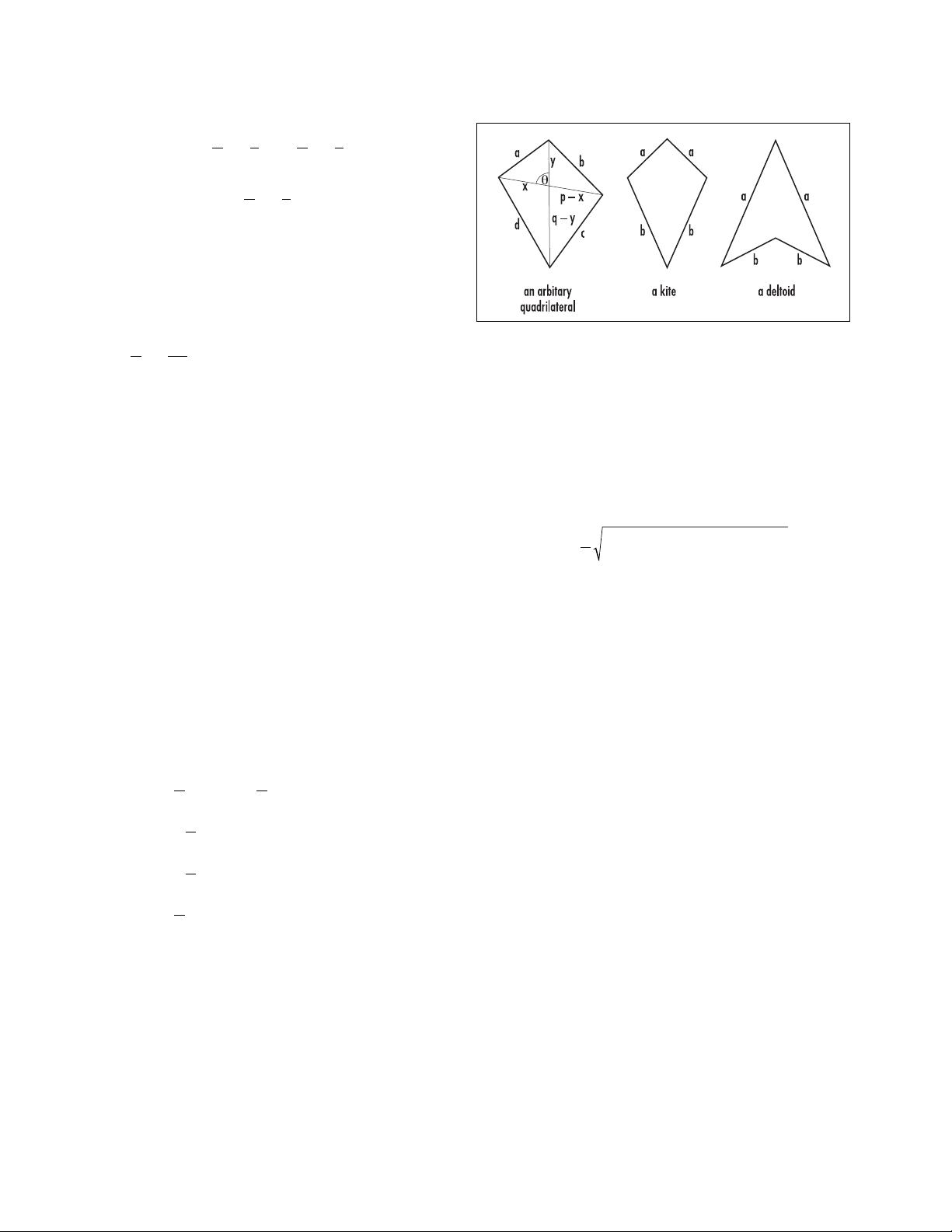
430 quadrilateral
Quadrilaterals
This is a factorization with integral coefficients.
For the quadratic expression 8x2+ 2x– 3, we
selected p= –4 and q= 6. Then d= gcd(8,–4) = 4 and
e= gcd(–3,6) = 3, again yielding the factorization
.
A quadratic form is a homogeneous polynomial of
degree two. For example, ax2+ bxy + cy2is a quadratic
form in two variables. A quadratic curve is a curve
given by an algebraic equation of second degree. For
example, a
CIRCLE
, given by an equation of the form
(x– a)2+ (y– b)2= r2, is a quadratic curve.
See also
HISTORY OF EQUATIONS AND ALGEBRA
(essay).
quadrilateral (quadrangle, tetragon) Any
POLYGON
with four sides is called a quadrilateral. For example,
any
SQUARE
,
TRAPEZIUM
, or
PARALLELOGRAM
is a
quadrilateral. Kites and deltoids are quadrilaterals
whose adjacent sides are equal in pairs.
If pand qare the lengths of the diagonals of a con-
vex quadrilateral, and θis the angle between them,
then the
AREA
of the quadrilateral is given as the sum
of the areas of the four triangles they create:
Applying the
LAW OF COSINES
to each the four triangles
and summing yields the second equation:
b2+ d2– a2– c2= 2pqcos(θ).
(Here a, b, c and dare the side-lengths of the quadri-
lateral as shown in the diagram.) Solving for sin(θ) in
the first equation and for cos(θ) in the second and
substituting into the equation cos2(θ)+sin2(θ) = 1, a
standard identity in
TRIGONOMETRY
, yields one ver-
sion of B
RETSCHNEIDER
’
S FORMULA
for the area of a
quadrilateral:
Analogous arguments show that these two formulae
for area hold for concave quadrilaterals also.
A quadrilateral is called a cyclic quadrilateral if it
is a
CYCLIC POLYGON
, that is, if its four vertices lie on a
circle. A consequence of the
CIRCLE THEOREMS
shows
that opposite interior angles of a cyclic quadrilateral
sum to 180°. The area of a cyclic quadrilateral is given
by B
RAHMAGUPTA
’
S FORMULA
.
Every quadrilateral, no matter its shape, provides a
TESSELLATION
of the plane, that is, copies of any single
quadrilateral tile can be used to cover the entire plane
without overlap.
See also
CONCAVE
/
CONVEX
; P
TOLEMY
’
S THEOREM
.
quantifier In English, we frequently encounter state-
ments containing the words all, some, and no (or
none). These words are called quantifiers. For example,
“All math books are boring,” “Some lakes contain
fresh water,” and “No poet plays the viola” are quanti-
fied statements.
Mathematicians reduce all quantified statements to
two standard forms by use of either the universal quan-
tifier: “for all,” denoted , or the existential quantifier:
“there exists,” denoted ∃. For example, the statement
A
area =−+−−
()
1
4422 2 2 2 2
2
pq b d a c
area
=+−−
+− −
+− −
=
1
2
1
2
1
2180
1
2180
1
2
xy p x q y
yp x
xq y
pq
sin( ) ( )( )sin( )
( )sin( )
( )sin( )
sin( )
θθ
θ
θ
θ
o
o
()( )()()43
8
4
3
34321xx xx++
−=+ −
dx a
dxc
eea
dxc
e
dx e a
dxc
e
=+
++
=+
()
+